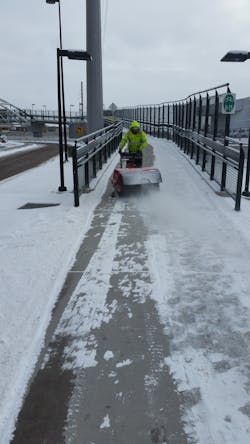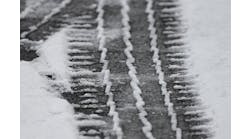To the men and women who handle snow operations in Denver, twenty deployments each season to plow nearly 5 ft of annual snow is just another day at the office. It goes with the job, and the staff handle the shift changes and varying conditions with aplomb. Like much of the country, however, Denver is experiencing a cultural shift that requires new equipment and tactics to address the safety needs of the traveling public.
The buzz-word is multimodal; this means that street cross-sections now are laid out to provide dedicated access to multiple forms of transit. There are now separate lanes for buses, cars, bicycles, and wider sidewalks containing pedestrian amenities and other features. For the most part, plowing the vehicle lanes was never a big issue. Lanes were wide and there was plenty of storage for snow in, or adjacent to the parking lanes. With the increased installation of dedicated bicycle lanes, the area once used for snow storage has now become a travel lane. Hauling snow from these lanes is not a realistic option. The work is time-consuming and expensive, plus it requires a location to store the snow with proper drainage facilities to collect debris and filter the melt water before it reenters the environment as point discharges with higher concentrations of deicers. Denver Public Works staff have worked with the bicycle community to inform the public that cyclists need to expect most bike lanes to be considered as shared lane configurations while plowing operations are in effect and for a short time after snow has ended.
Protected bike lanes, also called cycle tracks, are expanding in their use. These lanes are separated from vehicle lanes by physical barriers or set at elevations a few inches higher than the other street pavement. To clear these areas of snow, smaller equipment is necessary. This results in additional capital equipment and personnel outlay to maintain safe traveling conditions in these areas. In Denver, a separate crew was created to clear bicycle lanes and pedestrian bridges with plowing, deicer distribution and sweeping capabilities.
Improvements to pedestrian travel ways has resulted in wider sidewalks; improvements to bus stops and amenities such as benches, lights and vegetation along walks; and bulb outs and medians to shorten crossing distances. All of these act as obstructions to plowing efforts, whether it is large plows in the streets, or the smaller units working behind the curb. They can also minimize the area available for snow storage. Additionally, pedestrian ramps at street crossings can collect snow and ice, especially in the truncated domes at the base of the ramps. Providing full accessibility to all members of our community is important, so these are all items that are vital to consider when considering potential multimodal transportation methods.
Public education and enforcement of snow clearing rules and methodology are fundamental components of any plan to keep all means of transportation safe and open to all travelers. It is easy for the efforts to clear snow for one travel method to adversely impact the adjacent one. It does not matter if it is Public Works with plows on the streets and bike ways, business districts clearing the sidewalks, or individual homeowners clearing the walkways in front of their homes. Everyone must work in concert to provide a safe environment for the traveling public. Snow response is more than simply sending the plows out. Attention to details along each route, coordinated efforts, and public education are now staples to a full and responsible emergency snow response plan.


